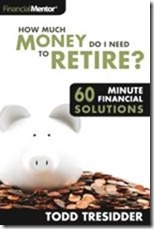 This book, by Todd Tresidder, cuts through much of the extra “stuff” that you find about retirement planning, to help you do some really useful, back-of-a-napkin retirement planning for yourself.
This book, by Todd Tresidder, cuts through much of the extra “stuff” that you find about retirement planning, to help you do some really useful, back-of-a-napkin retirement planning for yourself.
Tresidder, who has a practice coaching folks with financial planning based on his concepts, developed his planning methods in real practice for himself. Tresidder “retired” from his regular job at the age of 35 using these tactics, and has been helping other folks to use these methods in planning for retirement ever since.
In this book, Todd goes through the conventional methods of planning for retirement savings, which includes gathering some information that is impossible to calculate:
How much money will you need every year for the rest of your life?
What will be the rate of inflation?
When will you die? Your spouse?
What rate of growth will your investments experience over your lifetime?
What will be the sequence of returns that your investments achieve?
When will you and your spouse retire?
In reviewing these questions, Tresidder points out how difficult it is to develop these numbers for yourself, and then he points out flaws in the conventional methods of determining or estimating these numbers.
Upon reaching a conclusion about the problems with the conventional method of retirement planning, the author then goes on to lay out his methods for determining the amount of money required for you to retire. His methods are definitely different from the conventional methods, and he gives his reasons for believing that they will provide a useful gauge for you. I don’t disagree with his findings – I believe he has some very good information to pass along here.
One example of Tresidder’s decision-points is determining an appropriate withdrawal rate from your invested assets. Tresidder says that the primary factor to use in determining the sustainable withdrawal rate on your investments is the price/earnings ratio in the overall market as of your date of retirement. The higher the PE ratio, the lower your sustainable withdrawal rate. I won’t ruin the surprise by explaining it all here, you should read the book if you are interested.
One interesting factor about this book is that Tresidder takes great pains to point out that he believes any planning that is based on past information has flaws. At the same time, his sustainable withdrawal rate conclusion depends entirely upon a back-test of historical information. I believe that this anomaly just points out that you must have some historical information to work from – and all methods of planning for the future have shortfalls.
I think this is a great book for anyone who is looking for a do-it-yourself method for planning your retirement. I would also use other methods to test your results against, since all methods of predicting the future have flaws. Using a few options to test against one another is a great way to help ensure your success in financial dealings.


 Sterling Raskie, MSFS, CFP®, ChFC®
Sterling Raskie, MSFS, CFP®, ChFC® The latest in our Owner’s Manual series, A 401(k) Owner’s Manual, was published in January 2020 and is available on
The latest in our Owner’s Manual series, A 401(k) Owner’s Manual, was published in January 2020 and is available on  A Medicare Owner’s Manual, is updated with 2020 facts and figures. This manual is available on
A Medicare Owner’s Manual, is updated with 2020 facts and figures. This manual is available on  Social Security for the Suddenly Single can be found on Amazon at
Social Security for the Suddenly Single can be found on Amazon at  Sterling’s first book, Lose Weight Save Money, can be
Sterling’s first book, Lose Weight Save Money, can be  An IRA Owner’s Manual, 2nd Edition is available for purchase on Amazon. Click the link to choose the
An IRA Owner’s Manual, 2nd Edition is available for purchase on Amazon. Click the link to choose the  Jim’s book – A Social Security Owner’s Manual, is now available on Amazon. Click this link for the
Jim’s book – A Social Security Owner’s Manual, is now available on Amazon. Click this link for the  And if you’ve come here to learn about queuing waterfowl, I apologize for the confusion. You may want to discuss your question with Lester, my loyal watchduck and self-proclaimed “advisor’s advisor”.
And if you’ve come here to learn about queuing waterfowl, I apologize for the confusion. You may want to discuss your question with Lester, my loyal watchduck and self-proclaimed “advisor’s advisor”.